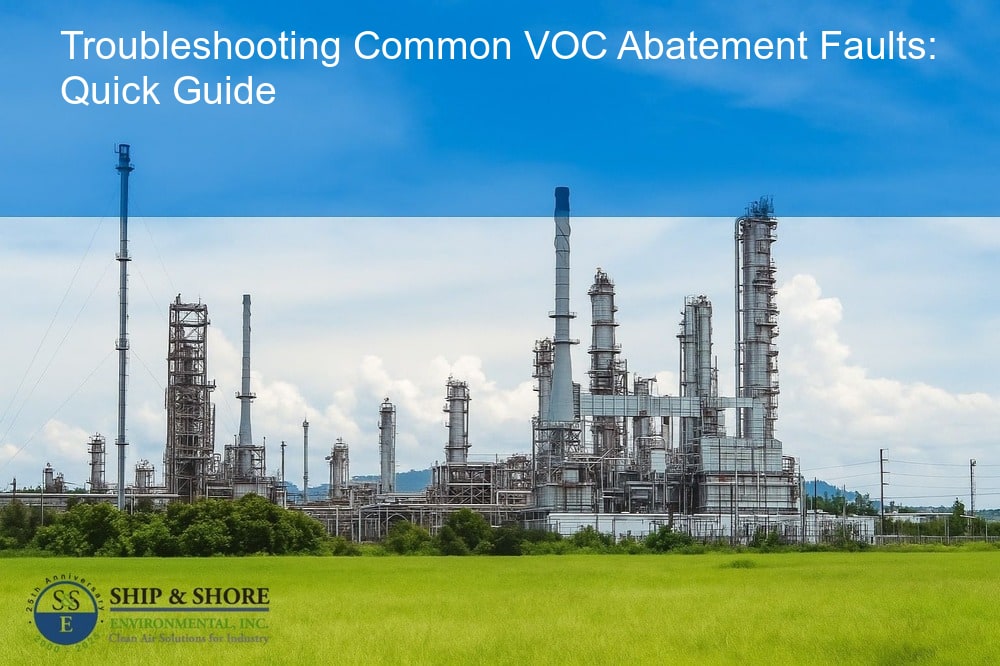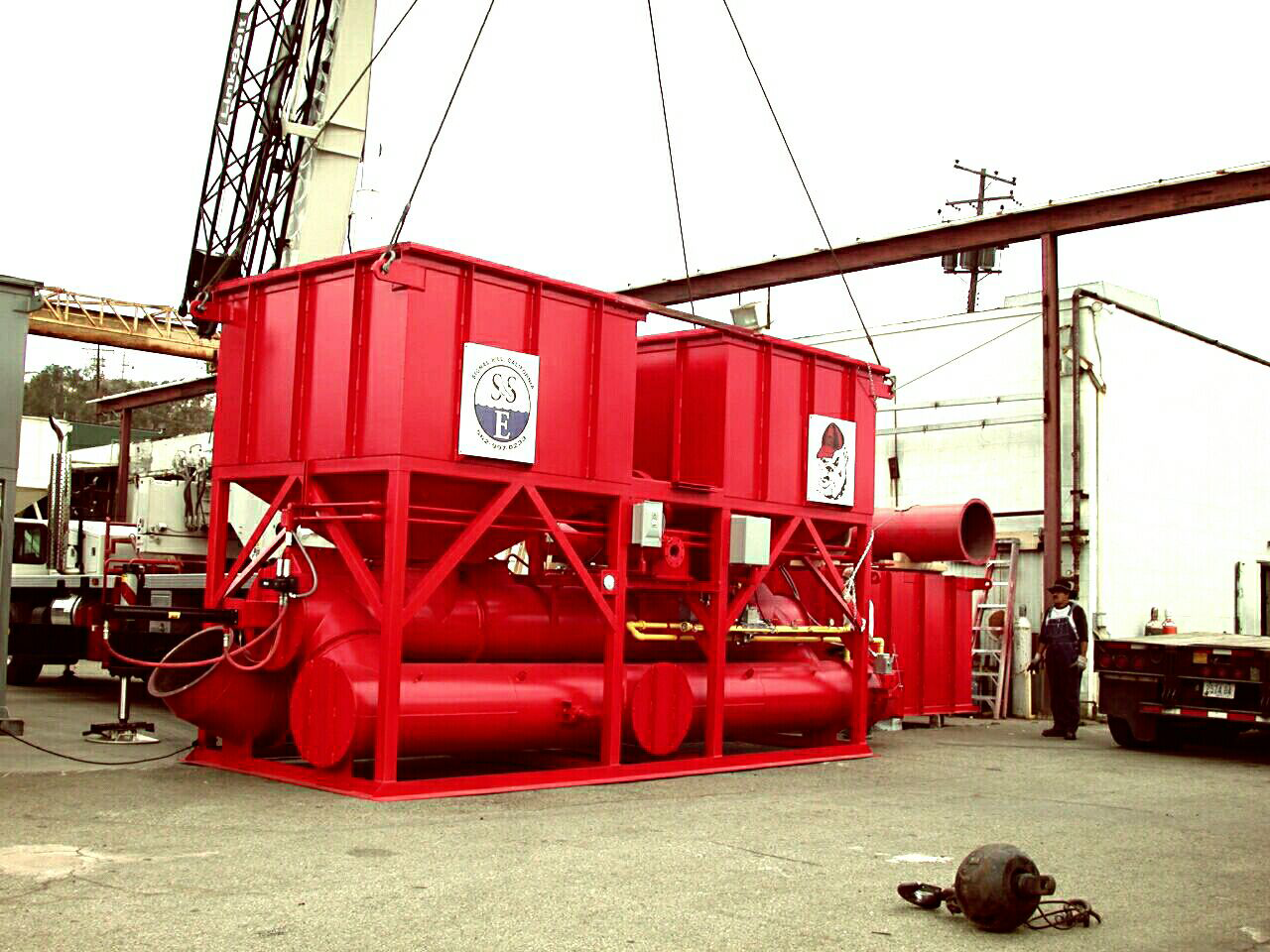
Troubleshooting Common VOC Abatement Faults: A Proactive Guide
October 24, 2025 6:45 amUnderstanding the Importance of VOC Abatement Systems
In the realm of industrial and environmental engineering, the effective management of Volatile Organic Compounds (VOCs) is crucial. These compounds, often byproducts of industrial processes, can pose significant environmental and health risks if not properly controlled and mitigated. This is where VOC abatement systems come into play, providing a robust solution for minimizing the release of harmful VOCs into the atmosphere. However, even the most well-designed systems can encounter issues, making it essential for us at Ship & Shore Environmental, Inc. to master the art of troubleshooting common VOC abatement faults. Efficient troubleshooting ensures that our systems perform optimally, safeguarding both the environment and compliance with regulatory standards.
Defining Faults in VOC Abatement Systems
To effectively troubleshoot VOC abatement faults, we must first understand what constitutes a fault. In the context of VOC abatement, faults can range from minor inefficiencies to significant breakdowns that impede the system’s ability to capture and neutralize VOCs. Common faults include issues with airflow, temperature control, sensor malfunctions, and component wear and tear. Identifying these problems early can prevent more severe consequences, such as non-compliance with environmental regulations, increased operational costs, and potential harm to surrounding communities and ecosystems.
The Relevance of Troubleshooting in Ensuring System Effectiveness
Troubleshooting is not just a reactive measure; it’s a proactive approach to maintaining the health of our VOC abatement systems. Regular monitoring and early detection of potential issues can significantly enhance the efficiency and longevity of our systems. Effective troubleshooting helps in maintaining optimal operational parameters, ensuring that the system’s components work in harmony to deliver the best outcomes. This proactive stance not only saves time and resources but also builds trust with our clients and regulatory bodies who rely on our systems to maintain environmental standards.
Identifying Common VOC Abatement System Failures
Volatile Organic Compounds (VOC) abatement systems are crucial in maintaining a clean and compliant industrial environment. However, like all complex systems, they are prone to various failures. Some of the most common issues include thermal oxidizer inefficiencies, catalyst fouling, and mechanical failures such as blower or fan malfunctions. Furthermore, sensor inaccuracies and electrical issues can also disrupt system performance. Identifying these failures quickly is essential, as prolonged downtime could lead to non-compliance and environmental harm.
Troubleshooting Common VOC Abatement Faults
Easy Steps to Troubleshoot Common VOC Abatement Issues
Troubleshooting common VOC abatement faults involves a systematic approach. Initially, we should start by reviewing the operating manual and logs for any signs of irregularities. Next, verify that all electrical connections are secure, as loose connections can cause various problems. Additionally, it is essential to check and replace sensors or gauges that are out of calibration.
- Thermal Oxidizer Issues: Inspect the burners, pilot lights, and fuel supply. Ensure that the combustion flame is steady and blue. If you detect an irregular flame, it could indicate poor fuel quality or an issue with the burner itself.
- Catalyst Fouling: Observe pressure drops across the catalyst bed. Significant pressure drops often point to fouling. Cleaning or replacing the catalyst can resolve this issue.
- Mechanical Failures: Examine blowers, fans, and ductwork. Listen for unusual noises, which often point to mechanical wear or damage. Lubricate moving parts and replace any damaged components to restore functionality.
- Sensor Inaccuracies: Calibrate or replace faulty sensors. A simple comparison between sensor outputs and a trusted reference can verify accuracy. Regular sensor checks are advisable to avoid incorrect readings.
Realizing the Role of Expert Assistance in Troubleshooting VOC Abatement System Faults
While basic troubleshooting might resolve several issues, some problems require professional expertise. Our team at Ship & Shore Environmental, Inc. is equipped with the advanced diagnostic tools necessary for a thorough system evaluation. We recommend seeking expert assistance to handle complex failures or when initial troubleshooting steps do not resolve the issue. Having experts assess the system ensures that solutions are not just temporary fixes but address the root causes effectively.
Did you know? Regular monitoring of VOC abatement systems can prevent faults that might otherwise lead to hazardous air pollution and safety risks. Troubleshooting is crucial for maintaining air quality.
Reviewing the Key Steps in Troubleshooting Common VOC Abatement Faults
Ensuring the optimal functioning of our VOC abatement systems is paramount for maintaining environmental standards and adhering to regulations. By identifying and understanding common faults, we empower ourselves to keep the systems running efficiently. Troubleshooting common VOC abatement faults starts with recognizing typical issues such as sensor malfunctions, blockage in airflows, and inefficient burning processes. With a systematic approach, we can address these problems by checking and rectifying issues like damaged components, clogged filters, or incorrect system settings.
Highlighting the Importance of Regular Maintenance and Monitoring
Regular maintenance and monitoring of our VOC abatement systems are essential to preempt faults and prolong the lifespan of the equipment. By implementing scheduled inspections and routine checks, we minimize unexpected downtimes and costly repairs. Maintenance tasks could include cleaning filters, calibrating sensors, and ensuring the integrity of all components. Continuous monitoring with automated systems helps in early detection of potential faults, providing data that can guide proactive troubleshooting and timely interventions.
Encouraging a Proactive Approach to VOC Abatement Failure Prevention
Adopting a proactive approach towards VOC abatement system maintenance not only mitigates risks but also enhances overall performance. Leveraging the expertise of our dedicated specialists, we can create and follow a robust maintenance strategy. Additionally, utilizing our aftermarket services ensures that we have access to essential support and spare parts, enabling swift and effective resolution of any issues that may arise. By prioritizing prevention and swift troubleshooting, we safeguard our operations and contribute to a cleaner, healthier environment.
FAQ
What are some common faults in our VOC abatement systems?
Common faults may include sensor malfunctions that affect the system’s ability to measure VOC levels accurately, blockage in airflows that can lead to system inefficiency, and issues with the burning process that can result in incomplete VOC destruction. Promptly addressing these issues maintains the effectiveness of the system.
How can we effectively troubleshoot issues with VOC abatement systems?
To effectively address potential problems, begin by systematically checking for damaged components, ensuring filters are not clogged, and verifying the system settings are correct. Following these initial steps may resolve many of the issues at hand, and if complications persist, consulting an expert is highly advised.
Why is regular maintenance crucial for VOC abatement systems?
Regular maintenance enhances the performance and prolongs the lifespan of the VOC abatement system. Through scheduled inspections and routine checks, like cleaning filters and calibrating sensors, our operation minimizes unexpected downtimes, maintains compliance with environmental regulations, and reduces the likelihood of costly repairs.
What are the benefits of a proactive maintenance strategy for VOC abatement systems?
A proactive maintenance strategy ensures a consistent and reliable operation of the VOC abatement system. By anticipating potential failures and addressing them before they become critical issues, our operation remains efficient, reduces the risk of regulatory non-compliance, and supports a commitment to environmental stewardship.
How do continuous monitoring and aftermarket services contribute to VOC abatement system reliability?
Continuous monitoring helps in the early detection of potential issues, allowing for timely intervention. Utilizing our aftermarket services guarantees access to expert support, spare parts, and swift issue resolution. Therefore, we establish a robust line of defense against system failures, ensuring reliability and peak performance.
Categorised in: Blog

